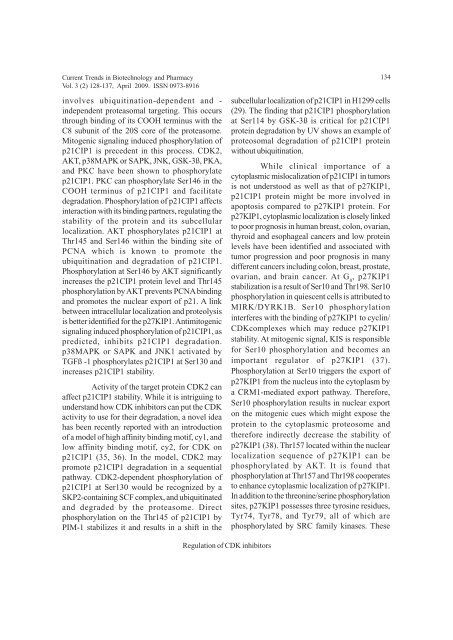April Journal-2009.p65 - Association of Biotechnology and Pharmacy
April Journal-2009.p65 - Association of Biotechnology and Pharmacy
April Journal-2009.p65 - Association of Biotechnology and Pharmacy
You also want an ePaper? Increase the reach of your titles
YUMPU automatically turns print PDFs into web optimized ePapers that Google loves.
Current Trends in <strong>Biotechnology</strong> <strong>and</strong> <strong>Pharmacy</strong><br />
Vol. 3 (2) 128-137, <strong>April</strong> 2009. ISSN 0973-8916<br />
involves ubiquitination-dependent <strong>and</strong> -<br />
independent proteasomal targeting. This occurs<br />
through binding <strong>of</strong> its COOH terminus with the<br />
C8 subunit <strong>of</strong> the 20S core <strong>of</strong> the proteasome.<br />
Mitogenic signaling induced phosphorylation <strong>of</strong><br />
p21CIP1 is precedent in this process. CDK2,<br />
AKT, p38MAPK or SAPK, JNK, GSK-3ß, PKA,<br />
<strong>and</strong> PKC have been shown to phosphorylate<br />
p21CIP1. PKC can phosphorylate Ser146 in the<br />
COOH terminus <strong>of</strong> p21CIP1 <strong>and</strong> facilitate<br />
degradation. Phosphorylation <strong>of</strong> p21CIP1 affects<br />
interaction with its binding partners, regulating the<br />
stability <strong>of</strong> the protein <strong>and</strong> its subcellular<br />
localization. AKT phosphorylates p21CIP1 at<br />
Thr145 <strong>and</strong> Ser146 within the binding site <strong>of</strong><br />
PCNA which is known to promote the<br />
ubiquitination <strong>and</strong> degradation <strong>of</strong> p21CIP1.<br />
Phosphorylation at Ser146 by AKT significantly<br />
increases the p21CIP1 protein level <strong>and</strong> Thr145<br />
phosphorylation by AKT prevents PCNA binding<br />
<strong>and</strong> promotes the nuclear export <strong>of</strong> p21. A link<br />
between intracellular localization <strong>and</strong> proteolysis<br />
is better identified for the p27KIP1. Antimitogenic<br />
signaling induced phosphorylation <strong>of</strong> p21CIP1, as<br />
predicted, inhibits p21CIP1 degradation.<br />
p38MAPK or SAPK <strong>and</strong> JNK1 activated by<br />
TGFß -1 phosphorylates p21CIP1 at Ser130 <strong>and</strong><br />
increases p21CIP1 stability.<br />
Activity <strong>of</strong> the target protein CDK2 can<br />
affect p21CIP1 stability. While it is intriguing to<br />
underst<strong>and</strong> how CDK inhibitors can put the CDK<br />
activity to use for their degradation, a novel idea<br />
has been recently reported with an introduction<br />
<strong>of</strong> a model <strong>of</strong> high affinity binding motif, cy1, <strong>and</strong><br />
low affinity binding motif, cy2, for CDK on<br />
p21CIP1 (35, 36). In the model, CDK2 may<br />
promote p21CIP1 degradation in a sequential<br />
pathway. CDK2-dependent phosphorylation <strong>of</strong><br />
p21CIP1 at Ser130 would be recognized by a<br />
SKP2-containing SCF complex, <strong>and</strong> ubiquitinated<br />
<strong>and</strong> degraded by the proteasome. Direct<br />
phosphorylation on the Thr145 <strong>of</strong> p21CIP1 by<br />
PIM-1 stabilizes it <strong>and</strong> results in a shift in the<br />
134<br />
subcellular localization <strong>of</strong> p21CIP1 in H1299 cells<br />
(29). The finding that p21CIP1 phosphorylation<br />
at Ser114 by GSK-3ß is critical for p21CIP1<br />
protein degradation by UV shows an example <strong>of</strong><br />
proteosomal degradation <strong>of</strong> p21CIP1 protein<br />
without ubiquitination.<br />
While clinical importance <strong>of</strong> a<br />
cytoplasmic mislocalization <strong>of</strong> p21CIP1 in tumors<br />
is not understood as well as that <strong>of</strong> p27KIP1,<br />
p21CIP1 protein might be more involved in<br />
apoptosis compared to p27KIP1 protein. For<br />
p27KIP1, cytoplasmic localization is closely linked<br />
to poor prognosis in human breast, colon, ovarian,<br />
thyroid <strong>and</strong> esophageal cancers <strong>and</strong> low protein<br />
levels have been identified <strong>and</strong> associated with<br />
tumor progression <strong>and</strong> poor prognosis in many<br />
different cancers including colon, breast, prostate,<br />
ovarian, <strong>and</strong> brain cancer. At G 0<br />
, p27KIP1<br />
stabilization is a result <strong>of</strong> Ser10 <strong>and</strong> Thr198. Ser10<br />
phosphorylation in quiescent cells is attributed to<br />
MIRK/DYRK1B. Ser10 phosphorylation<br />
interferes with the binding <strong>of</strong> p27KIP1 to cyclin/<br />
CDKcomplexes which may reduce p27KIP1<br />
stability. At mitogenic signal, KIS is responsible<br />
for Ser10 phosphorylation <strong>and</strong> becomes an<br />
important regulator <strong>of</strong> p27KIP1 (37).<br />
Phosphorylation at Ser10 triggers the export <strong>of</strong><br />
p27KIP1 from the nucleus into the cytoplasm by<br />
a CRM1-mediated export pathway. Therefore,<br />
Ser10 phosphorylation results in nuclear export<br />
on the mitogenic cues which might expose the<br />
protein to the cytoplasmic proteosome <strong>and</strong><br />
therefore indirectly decrease the stability <strong>of</strong><br />
p27KIP1 (38). Thr157 located within the nuclear<br />
localization sequence <strong>of</strong> p27KIP1 can be<br />
phosphorylated by AKT. It is found that<br />
phosphorylation at Thr157 <strong>and</strong> Thr198 cooperates<br />
to enhance cytoplasmic localization <strong>of</strong> p27KIP1.<br />
In addition to the threonine/serine phosphorylation<br />
sites, p27KIP1 possesses three tyrosine residues,<br />
Tyr74, Tyr78, <strong>and</strong> Tyr79, all <strong>of</strong> which are<br />
phosphorylated by SRC family kinases. These<br />
Regulation <strong>of</strong> CDK inhibitors













